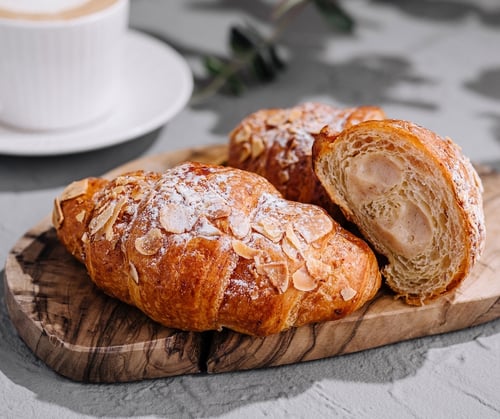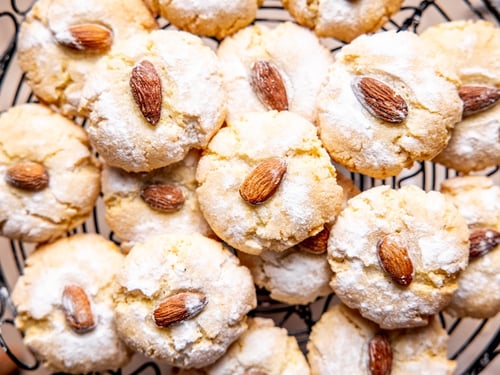Almond Filling vs. Almond Paste: What's the Difference?
- By Charlotte Brown
- September 29, 2025
From delicate tarts to buttery puff pastry braids, almond-based pastries are a favorite in professional kitchens and bakeries. Yet even among seasoned chefs, the terms almond filling and almond paste are often used interchangeably—but they’re far from identical.
Understanding the difference between almond filling vs. almond paste isn’t just a matter of terminology; it’s the key to unlocking flavor, texture, and versatility in your pastry work.
Almond paste is the foundation, and almond filling is the finished product ready to spread and bake. And here’s the best part: with the right technique, you can transform almond paste into a luscious almond filling, opening the door to endless creative applications.
Want to learn more about utilizing these delicious ingredients? You’re in the right place.
Almond Filling vs. Almond Paste: The Key Differences
Though they share the same primary ingredient (almonds, of course), these two products serve very different purposes in the pastry kitchen.
Almond Paste
- Texture: Semi-firm, smooth, moldable
- Purpose: Used as a base ingredient, not typically enjoyed as-is
- Flavor: Delicate, nutty, with a slight bitter edge
Almond Filling
- Texture: Soft, creamy, and spreadable
- Purpose: Ready-to-use for direct application in pastries
- Flavor: Sweeter, with a more pronounced almond profile
Quick takeaway: Think of almond paste as the building block—and almond filling as the finished spread.
Almond Filling vs. Almond Paste: Quick Comparison |
||
|
Feature |
Almond Paste |
Almond Filling |
|
Texture |
Semi-firm, smooth, moldable |
Soft, creamy, spreadable |
|
Flavor |
Delicate, nutty, slightly bitter edge |
Sweeter, more pronounced almond flavor |
|
Purpose |
Base ingredient for creating fillings, frangipane, cookies, cakes, and chocolates |
Ready-to-use spread for pastries, tarts, and braids |
|
Usage |
Requires preparation or blending with other ingredients |
Can be used directly in recipes |
|
Best Applications |
Frangipane, marzipan, cookies, cakes, chocolates |
Puff pastry braids, turnovers, mini tarts, Danish pastries |
How to Make Almond Filling from Almond Paste
With the proper technique, almond paste transforms from a semi-firm base into a versatile, spreadable filling that works beautifully in a wide range of pastries. The process is simple!
Ingredients (Yields about 3 cups of almond filling):
- Almond Paste — 8 oz (225 g) Try Nutley Farms Almond Paste
- Granulated sugar — ½ cup (100 g)
- Unsalted butter, softened — ½ cup (113 g)
- Large eggs — 2 (about 100 g)
Step-by-Step Instructions:
- Cream the base: Break the almond paste into small pieces and cream together with the sugar until smooth and lump-free.
- Incorporate the butter: Add softened butter and continue mixing until light and fluffy.
- Add the eggs: Beat in the eggs one at a time, ensuring each is fully incorporated before adding the next. Continue mixing until the filling reaches a smooth, spreadable consistency.
- Chill or use immediately: The filling can be used immediately in pastries or refrigerated for later use.
Pro tip: This method not only gives you a ready-to-use almond filling but also allows you to control sweetness, texture, and richness to suit your recipe.
Applications: Almond Paste Meets Puff Pastry

Few combinations are as satisfying as almond filling and puff pastry. The buttery, flaky layers provide the perfect canvas for a rich, nutty center, creating pastries that are both elegant and indulgent. A few timeless applications include:
- Almond Braid – A classic breakfast pastry where almond filling is spread over puff pastry, braided, and baked until golden. Perfect with a light glaze or sliced almonds on top.
- Mini Almond Tarts – Bite-sized pastry shells filled with almond filling for a refined dessert or petit four option.
- Almond Turnovers – Flaky triangles of puff pastry enveloping almond filling, ideal for café menus and grab-and-go service.
- Croissants – Transforms classic croissants into almond croissants when layered with almond paste or filling and baked to perfection.
Beyond Fillings: Other Ways Chefs Use Almond Paste

Almond paste isn’t limited to puff pastry fillings—it’s one of the most versatile ingredients in a pastry chef’s toolkit. Here are just a few other ways it shines:
- Cookies – Adds moisture, richness, and a subtle almond flavor, especially in traditional European varieties.
- Chocolates – Rolled, molded, or enrobed, almond paste offers a nutty surprise inside truffles and confections.
- Cakes – Enhances flavor and texture, lending density and aroma to sponge cakes, tea cakes, and festive bakes.
- Macarons – Contributes to a smooth, chewy almond macaron shell with authentic flavor.
Product Spotlight: Nutley Farms Almond Paste 60%
.webp?width=400&height=493&name=AG5352%20Almond%20paste%20blanch%2060%25%20(1).webp)
When it comes to consistency, flavor, and quality, Nutley Farms delivers an almond paste that pastry chefs can rely on.
Crafted from blanched California almonds and pure cane sugar, this paste is cooked to a smooth, semi-firm texture that makes it easy to work with across many delectable pastry applications.
Ingredients: Almonds, sugar, bitter almond oil, potassium sorbate
Nutley Farms Almond Paste provides a dependable foundation. It’s versatile enough to serve as both the base ingredient for innovation and the key to authentic, traditional recipes.
Pro Tip: Experiment with Nutley Farms Almond Paste in your kitchen and discover how a single product can unlock dozens of pastry possibilities.
Unlock the Possibilities with Nutley Farms Almond Paste
When chefs understand how to unlock almond paste’s potential, they don’t just elevate individual recipes—they expand their entire pastry toolkit with one essential ingredient.
Invest in Nutley Farms Almond Paste and other almond products and unlock all the delicious almond-flavored possibilities!

